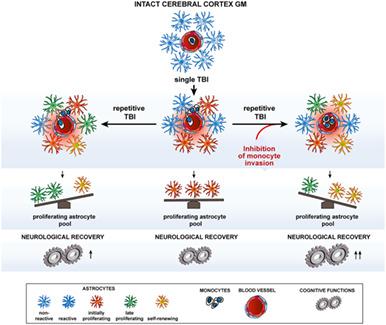Our official English website, www.x-mol.net, welcomes your feedback! (Note: you will need to create a separate account there.)
Repetitive injury and absence of monocytes promote astrocyte self-renewal and neurological recovery.
Glia ( IF 6.2 ) Pub Date : 2020-08-03 , DOI: 10.1002/glia.23893 Luisa Lange Canhos 1, 2, 3 , Muxin Chen 1 , Sven Falk 1, 2 , Bastian Popper 4 , Tobias Straub 5 , Magdalena Götz 1, 2, 6 , Swetlana Sirko 1, 2
Glia ( IF 6.2 ) Pub Date : 2020-08-03 , DOI: 10.1002/glia.23893 Luisa Lange Canhos 1, 2, 3 , Muxin Chen 1 , Sven Falk 1, 2 , Bastian Popper 4 , Tobias Straub 5 , Magdalena Götz 1, 2, 6 , Swetlana Sirko 1, 2
Affiliation

|
Unlike microglia and NG2 glia, astrocytes are incapable of migrating to sites of injury in the posttraumatic cerebral cortex, instead relying on proliferation to replenish their numbers and distribution in the affected region. However, neither the spectrum of their proliferative repertoire nor their postinjury distribution has been examined in vivo. Using a combination of different thymidine analogs and clonal analysis in a model of repetitive traumatic brain injury, we show for the first time that astrocytes that are quiescent following an initial injury can be coerced to proliferate after a repeated insult in the cerebral cortex grey matter. Interestingly, this process is promoted by invasion of monocytes to the injury site, as their genetic ablation (using CCR2−/− mice) increased the number of repetitively dividing astrocytes at the expense of newly proliferating astrocytes in repeatedly injured parenchyma. These differences profoundly affected both the distribution of astrocytes and recovery period for posttraumatic behavior deficits suggesting key roles of astrocyte self‐renewal in brain repair after injury.
中文翻译:

重复性损伤和单核细胞缺失促进星形胶质细胞自我更新和神经恢复。
与小胶质细胞和 NG2 胶质细胞不同,星形胶质细胞不能迁移到创伤后大脑皮层的损伤部位,而是依靠增殖来补充它们在受影响区域的数量和分布。然而,它们的增殖谱系谱和损伤后分布均未在体内进行过检查。在重复性创伤性脑损伤模型中使用不同胸苷类似物和克隆分析的组合,我们首次表明,在大脑皮层灰质反复损伤后,初始损伤后静止的星形胶质细胞可以被迫增殖。有趣的是,单核细胞侵入损伤部位促进了这一过程,因为它们的基因消融(使用 CCR2 -/-小鼠)增加了重复分裂星形胶质细胞的数量,代价是在反复受伤的实质中新增殖的星形胶质细胞。这些差异深刻影响了星形胶质细胞的分布和创伤后行为缺陷的恢复期,表明星形胶质细胞自我更新在损伤后脑修复中的关键作用。
更新日期:2020-08-03
中文翻译:

重复性损伤和单核细胞缺失促进星形胶质细胞自我更新和神经恢复。
与小胶质细胞和 NG2 胶质细胞不同,星形胶质细胞不能迁移到创伤后大脑皮层的损伤部位,而是依靠增殖来补充它们在受影响区域的数量和分布。然而,它们的增殖谱系谱和损伤后分布均未在体内进行过检查。在重复性创伤性脑损伤模型中使用不同胸苷类似物和克隆分析的组合,我们首次表明,在大脑皮层灰质反复损伤后,初始损伤后静止的星形胶质细胞可以被迫增殖。有趣的是,单核细胞侵入损伤部位促进了这一过程,因为它们的基因消融(使用 CCR2 -/-小鼠)增加了重复分裂星形胶质细胞的数量,代价是在反复受伤的实质中新增殖的星形胶质细胞。这些差异深刻影响了星形胶质细胞的分布和创伤后行为缺陷的恢复期,表明星形胶质细胞自我更新在损伤后脑修复中的关键作用。


























 京公网安备 11010802027423号
京公网安备 11010802027423号